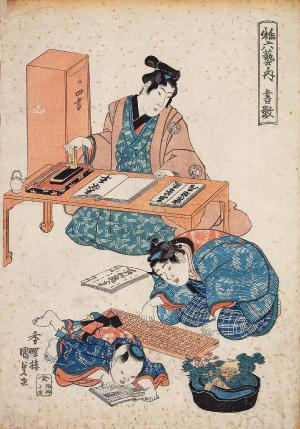From the Six Neccesary Subjects for Children, Calligraphy and Abaccus (Osanarikugei No Uchi Shosū)
Painted by Utagawa Kunisada I Tokyo Shiryō Collection 390-C2
From the term "rikugei", which means the six kinds of knowledge a wise man has, "osanarikugei" denotes the six subjects necessary for children to learn. "Sho" means calligraphy and "sū" means the Japanese abacus. Children learning "sho" and "sū" are depicted.
Rikugei was knowledge required in ancient China for people who held a rank higher than samurai. It means six kinds of knowledge including "Rei" (moral education), "Raku" (music), "Sha" (archery), "Gyo" (technique to operate horse cart), "Sho" (literature) and "Sū" (math).
Take a look the abacus in the picture. You can see two columns in the upper space (heaven) and five in the lower space (earth). The number of columns is one more than the current abacus in both the upper and lower spaces. This is the exact form of the kind of abacus that originated from China and in the Meiji period, abaci with one heaven column removed, leaving five columns of one heaven and five earth columns, became widespread. Then in 1935 (Shōwa 10), the present abacus with one column in the upper and four columns in the lower spaces appeared when learning abacus became a compulsory class.


